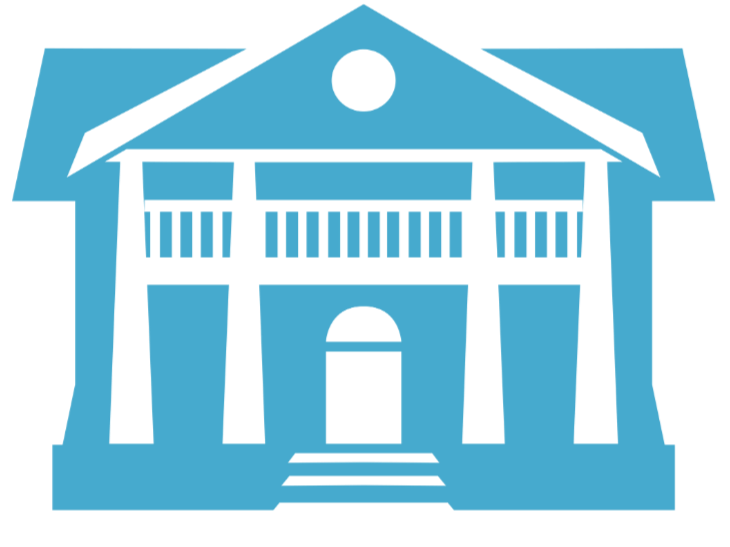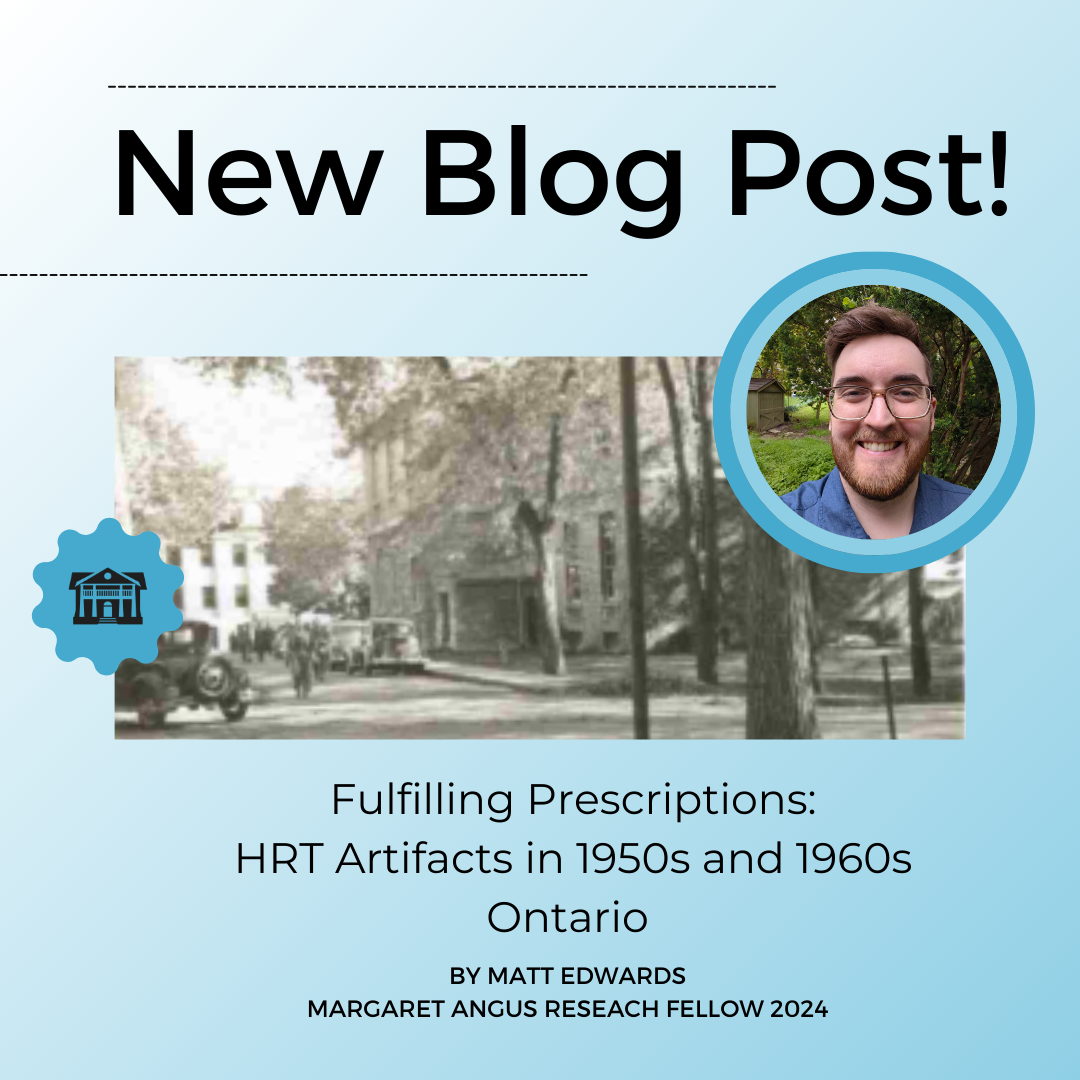Fulfilling Prescriptions: HRT Artifacts in 1950s and 1960s Ontario
HRT and Its Patients in the 1940s:
As we saw last week, hormone replacement therapies using estrogen, progesterone and testosterone had found a place among Canadian gynecologists and obstetricians by the early 1940s. Even before the Second World War began, drug manufacturers like Schering Ltd. (Montreal), Organon (Toronto) and Parke-Davis Co. (Walkerville and Brockville) had developed a network of labs and offices throughout Ontario. Beyond just selling crude extracts and synthesized hormones to Canadian researchers and physicians, these pharmaceutical companies also compiled and published research related to their products.
Postcard of the Parke Davis & Company Office and Laboratory Buildings in Walkerville, ON (now Windsor), 1927. From the Collection of the Southwestern Ontario Digital Archive, Mike Skreptak Collection; Box 1, R-77458. https://swoda.uwindsor.ca/node/2493 [1]
The Clinical Guides to sex hormone therapy published by Schering in 1941 (which we looked at in last week’s blog posts) showed us that Canadian doctors’ use of HRT generally developed on three fronts:
1) Gynaecology and obstetrics (endometriosis, menopause, contraception),
2) Behaviour/psychology (self-confidence, interests, sexuality)
3) Appearance (hair, anatomy, sex characteristics).
Although there are short sections in these guides on menopause and vaginal diseases, the majority focuses on the last category. Doctors and drug companies held considerable sway over who received HRT treatments and what the goals of those treatments were: the Clinical Guides approach HRT primarily as a means of dealing with the appearances of people with ambiguous, “underdeveloped” or “juvenile” sexual traits. Hormonal therapies were beginning to become associated with new programs at places like Johns Hopkins in Baltimore, which (in)famously used them to shape the sex characteristics of intersex children at this time.
The Museum of Health Care’s collections actually include several pharmaceutical artifacts related to these practices, which might help us uncover more about how Johns Hopkins’ research was received among Canadian physicians. These artifacts can teach us more about the gap between when hormones were made widely available and when they became aligned with gender-affirming practices in clinical spaces. Even though HRT is synonymous with trans healthcare today, this period and the impact it had on intersex peoples’ lives in the mid-to-late twentieth century remains an important, often unexplored part of Canada’s medical history.
Cortisone and HRT in Canada
For many historians, Johns Hopkins’ Pediatric Endocrinology Clinic was the place where the medical model of gender (as something distinct from sexual traits) was developed. Sandra Eder and Jules Gill-Peterson have both looked at the research this clinic conducted in the 1940s and 1950s. They focus particularly on the staff’s interest in Congenital Adrenal Hyperplasia (or CAH), a glandular condition that affects metabolism and salt retention along with growth, sex development and one’s appearance.
The staff at Johns Hopkins would, in the 1940s, start using cortisone, a steroid, to promote salt-retention and save their young patients’ lives. The staff also, however, became fascinated by cortisone’s ability to alter the children’s bodies and genitalia.
If a child’s sex characteristics were deemed too “ambiguous” by contemporary metrics, the Hopkins clinic would recommend cortisone and other hormones to better align their biology with the one that they viewed as most conducive to the patient’s future happiness –a judgement call which many intersex people note ignored what the patients wanted entirely.[2] The staff would deliberate whether children could successfully “adjust” to being male or female, often basing this on whether their appearance would not noticeably deviate from most peoples’ ideas about men or women’s physical traits. Their approach would, over time, come to be viewed as a gold standard for intersex case management worldwide, but would be adapted locally by physicians on the ground.
A photo of a chemistry class at Queen’s Medical School in 1940. Pierre Wolfe Fond, Box 1, File 3 (“First Meds Photos, 1940,”). Queen’s University Archives, F3063. http://db-archives.library.queensu.ca/index.php/pierre-wolfe-fonds [3]
Adrenal hormones like cortisone are sometimes underappreciated as a part of HRT and trans healthcare’s history. While “sex hormones” are certainly an important part of HRT’s meaning today, treatment programs for adrenal conditions like CAH set the foundation for future approaches, influencing their worldviews and the criteria they enforced on who was eligible for HRT.
Sandra Eder has noted, though, that adrenal hormones were (prior to mass production in 1950) were only available to a small network of consultants, researchers and doctors.[4] The limited availability of these substances, coupled with the prominence of John’s Hopkins in North America’s medical circles, makes it reasonable to assume that the pediatric endocrinology clinic’s work would be important throughout the continent. The Museum of Healthcare’s collection actually contains an adrenal hormone from before this mass production period called “eschatin.”
The vial of eschatin was produced locally in Canada by Parke, Davis & Co.’s Walkerville laboratory and appears to be suprarenal cortex extract, rather than a synthesized compound. One side of the box informs us that the brand name derives from the Greek word éschatos, meaning “cortex.” An interior circular addressed “To the Medical Profession,” emphasizes that “Eschatin is specifically indicated in treatment of adrenal insufficiency, Addison’s Disease being the classical example.” Addison’s Disease generally refers to the symptoms of adrenal insufficiency and comprises the symptomology of congenital adrenal hyperplasia’s various forms. Based on the packaging and circular, this bottle was released in 1942 at the earliest –seven years after cortisone had been isolated by Edward C. Kendall, but eight years before it was mass-produced.[5]
A bottle of Eschatin and the circular included for doctors prescribing it. Kingston Museum of Healthcare, 000001445 a-c. 1952 http://mhc.andornot.com/en/permalink/artifact4271 [6]
This artifact indicates two important things to us about HRT and adrenal hormones in Canada during this time. First, Parke Davis’ Walkverville lab extracted adrenal hormones for Canadian doctors’ use during a time when they were not widely available. Second, these adrenal hormones were intended to be used by physicians and specifically to treat Addison’s Disease, a fairly cutting-edge advancement in HRT at the time.
We can surmise that, rather than lagging behind the work at Johns Hopkins and merely following the United States, there were substantial research and treatment networks developing in Canada at the same time. How did students learn about these substances and their use? When did the Hopkins protocols come to be integrated into the teaching at medical schools like Queen’s? How did students and practitioners adapt, interpret and re-tool these ideas concerning sex, gender and healthcare?
Pierre Wolfe Fond, Box 1, File 3 (“First Meds Photos, 1940,”). Queen’s University Archives, F3063. http://db-archives.library.queensu.ca/index.php/pierre-wolfe-fonds [7]
Developing Relationships with HRT in Kingston:
The Museum has also preserved a set of sex hormones produced by Parke Davis in Ontario from this time. Estrogen injections/tablets and contraceptive pills were produced in Brockville and sold under names like Norlestrin and Theelin during the 1950s and 1960s. These drugs show us a material trace of the general trajectory of HRT in Canada as it moved from experimental, sex-focused work to contraception (in the form of ‘the pill’) and the treatment of menopause.
A box of Norlestrin, a contraceptive pill, produced and distributed in Ontario in 1965 by Parke Davis. Kingston Museum of Healthcare, 000001262 a-b. http://mhc.andornot.com/en/permalink/artifact4056 [8]
From these material artifacts, it remains clear that hormones’ manufacturers –including Merck, Parke-Davis and Organon— worked extensively to both create demand for hormonal therapies and make them available during and after the Second World War. The availability of these drugs is only one piece of this puzzle, however. Trying to zero in on how Johns Hopkins’ approach came to be influential among Canadian physicians (or, maybe, how they started working with cortisone on their own) raises questions about how doctors learned about and came to practice hormonal therapies. While clinical texts like the Schering guides were a part of this picture, medical schools and the role they played might shed even more light on how HRT entered onto the medical scene.
Special thanks to Ian M. Fraser and Janine M. Schweitzer for their generous support of the fellowship this year.
References
[1] Postcard of the Parke Davis & Company Office and Laboratory Buildings in Walkerville, ON (now Windsor), 1927. From the Collection of the Southwestern Ontario Digital Archive, Mike Skreptak Collection; Box 1, R-77458. https://swoda.uwindsor.ca/node/2493.
[2] Eder, How the Clinic Made Gender, 19.
[3] A photo of a chemistry class at Queen’s Medical School in 1940. Pierre Wolfe Fond, Box 1, File 3 (“First Meds Photos, 1940,”). Queen’s University Archives, F3063.
[4] Eder, How the Clinic Made Gender, 38-44.
[5] Eder, How the Clinic Made Gender, 39
[6] A bottle of Eschatin and the circular included for doctors prescribing it. Kingston Museum of Healthcare, 000001445 a-c. http://mhc.andornot.com/en/permalink/artifact4271
[7] A photo of the Medical Quadrangle at Queen’s University in 1940. The students being educated during and immediately after the Second World War would have done most of their lectures and pre-clinical work here. Pierre Wolfe Fond, Box 1, File 3 (“First Meds Photos, 1940,”). Queen’s University Archives, F3063. http://db-archives.library.queensu.ca/index.php/pierre-wolfe-fonds
[8] A box of Norlestrin, a contraceptive pill, produced and distributed in Ontario in 1965 by Parke Davis. Kingston Museum of Healthcare, Parke-Davis Collection, 1965. 000001262 a-b. http://mhc.andornot.com/en/permalink/artifact4056






